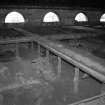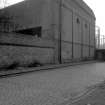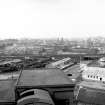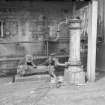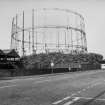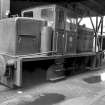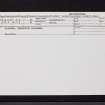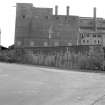Pricing Change
New pricing for orders of material from this site will come into place shortly. Charges for supply of digital images, digitisation on demand, prints and licensing will be altered.
Glasgow, 95 Kilbirnie Street, Tradeston Gasworks
Gas Works (19th Century) - (20th Century)
Site Name Glasgow, 95 Kilbirnie Street, Tradeston Gasworks
Classification Gas Works (19th Century) - (20th Century)
Alternative Name(s) Port Eglington; Maxwell Road; Gourock St; Tradeston Gas Holder Station
Canmore ID 44337
Site Number NS56SE 72
NGR NS 58180 63670
NGR Description Centred NS 58180 63670
Datum OSGB36 - NGR
Permalink http://canmore.org.uk/site/44337
- Council Glasgow, City Of
- Parish Govan (City Of Glasgow)
- Former Region Strathclyde
- Former District City Of Glasgow
- Former County Lanarkshire
NS56SE 72.00 centred 58180 63670
NS56SE 72.01 NS 58165 63630 Gasholder
NS56SE 72.02 NS 58220 63615 Gasholder
NS56SE 72.03 NS 58175 63525 Gasholder
NS56SE 72.04 NS 58198 63465 Water Meter House (in Maxwell Road)
For adjacent Rosehill Chemical Works, see NS56SE 175.
Tradeston Gas Holder Station [NAT]
(at NS 5817 6367)
OS 1:1250 map, 1982.
Tradeston Gasworks, 95 Kilbirnie St, built originally 1835-9 for Glasgow Gas Light Co (£20,000), and rebuilt 1869-74, 1924 and 1946-55. The works were closed officially on 31 March 1970. The General Terminus and Glasgow Harbour Rly intersects the works.
To the N is the retort house, of red brick, four storeys high, and coke store, reinforced concrete, five storeys high. There is a set of four condensors with cross water tubes, scrubbers, and foursets of steam-driven exhausters, two with engines by R Laidlaw and Son (1887-9). On the S side are the purifier houses, with Belfast roofs, the main coal store, and three of the four gasholders. The largest (Number one) was built by Barrowfield Ironworks in 1922, and rebuilt in 1928. Numbers two and three are similar in style, the latter being built in 1886 by Clayton. Number four, built by Barrowfield in 1897, is behind the offices on the N side, and was used for water gas storage.
A large brick and steel coal store in Gourock St was added in 1913 (£12,160), and there was a chemical works at Tradeston.
J R Hume 1974.
Publication Account (1949)
"Tradeston works, situated in Kilbrinie Street on the south side of the river, were built between 1835 and 1839, and acquired by the Corporation in 1869, when their manufacturing capacity was 1.5 million cubic feet per day.
In 1924, two new horizontal through retort benches were installed to work along with two blue water gas units, bringing the total manufacturing capacity to 5 million cubic feet per day. The blue water gas units were replaced by two carburetted water gas units in 1941, and the horizontal through retort benches replaced by two benches of modern vertical retorts in 1946.
The present day [1949] manufacturing capacity of the works is 7.5 million cubic feet per day. There are three gas holders having a total storage capacity of 6.8 million cubic feet. The area of the works is approximately 16 acres. The total number of employees at these works is 294."
Glasgow Corporation Gas Department, 1949.
Publication Account (1949)
Historical
The Tar and Ammonia Liquor produced during the process of gas manufacture is dealt with in the Chemical Works , which adjoins each of the four Gas Works (Provan, Temple and Dawsholm, Dalmarnock and Tradeston).
When Dalmarnock Gas Works was reopened for gas making late in 1915, the manager there superintended the working of the chemical works, the other three were leased to private firms, to whom the tar and liquor was charged at a price fixed monthly by an independent arbiter, and based o the tons of coal carbonised. ..ultimately...decided not to renew the contractor's leases then they expired in 1920.
On May 1st 1919, the first manager of the Chemical Works was appointed ...The total number of employees on 31st May 1948, was 286.
Description of Processes in the Chemical Section
General
The liquid by-products from the carbonisation of coal consist of ammoniacal liquor, tar, and the crude benzole extracted from the gas. The liquor and the tar are delivered by the several Gas Works into large underground tanks, called 'wells', of which the total capacity in the department is one and a half million gallons. Here a natural process of separation of the two liquids takes place, following which they are pumped to storage tanks, to undergo further separation by settling, and to await subsequent treatment. The Department can store 4,600,000 gallons of crude tar and liquor.
Ammoniacal Liquor
From the liquor is produced sulphate of ammonia for fertilising purposes.
Sulphate of Ammonia Plant
The original plant at Provan Chemical Works for the production of sulphate of ammonia had a guaranteed production of 25 tons of sulphate of ammonia per day. A new plant will shortly be in operation with a guaranteed output of 40 tons per day.
Tar
All four of the Chemical Works are fully equipped for the production , from crude tar, of refined road tars...but Provan Works alone can also deal with distilled products with the object of producing motor benzol, refined naphthas, , pyridine, phenol, ortho- and meta/para cresols, xylenols and high boiling cresylic acids, creosotes, black varnish etc. A very large quantity of mixed tar and bitumen is also prepared for road surfacing purposes at Dawsholm and Provan Works.
Distillation
The crude tar is subjected to distillation in stills, the capacity of each being 17 tons. The fuel used is coke breeze, and the residue remaining in the stills at the end of the operation is pitch. During the distillation the volatile products are separated into 'cuts' or fractions in accordance with thei composition of the use to which the fractions are to be put. The first 'cut' is the source of motor benzol and the naphthas, the second, of naphthalene and tar acids, whilst the later 'cuts' give the high boiling tar acids so highly prized as disinfectants.
Tar Acid Extraction
The condensates are naphtha or light oil, middle oil or heavy oil or creosote. When not required for sale as such, these liquids are treated for the removal of their tar acid content, and in the case of the naphthas , for their pyridine content as well. The oil from which the acid has been removed is known as 'spent' oil. That from the naphtha 'cut' goes forward for treatment for the removal of pyridine and subsequent rectification., that from the middle oil cut 'cut' is allowed to settle in pans to allow naphthalene to separate, while that from heavy oil is available for immediate use or sale.
The recovered tar acids are distilled, under vacuum, to yield the phenols and cresols used in 'plastics' manufacture and xylenols and high boiling point tar acids used in preparing sheep dips and disinfectants.
Pyridine Extraction
The tar -acids-free-naphtha fraction is washed with dilute sulphuric acid to form pyridine sulphate solution from which the addition of ammonia sets free the pyridine bases. These are dried and the dry bases distilled to give the commercial qualities of pyridine.
Naphtha Rectification
The tar acid and pyridine base free naphthas as well as the crude benzole from the coal gas are treated with concentrated sulphuric acids to destroy ...unsaturated bodies present, and are rectified by distillation through the fractionisation columns. Owing to the highly inflammable nature of the substances the when distillation is effected by steam. The products are motor benzol, tolulol, solvent naphtha, xylol, and high flash naphtha, all of which find application in industry.
Despatch of Products
Facilities are provided for the efficient handling of finished products. Sulphate of ammonia , naphthalene and agricultural lime are despatched in bags, ..[the lime] also in rail wagons and carts.; pitch goes out in bags, casks or rail wagons., while the remainder of the products being in liquid form leave in barrels, drums and road and rail tanks. The Department itself owns railway tank wagons which are used to transport material from the smaller works to Provan for further treatment, and also for the delivery of tar, creosote, tar acids, etc t customers. For the transport of tar and tar bitumen compounds to quarries etc. , the Department operates four motor road tanks each of 1,000 gallons capacity."
Glasgow Gas Department, 1949











































































